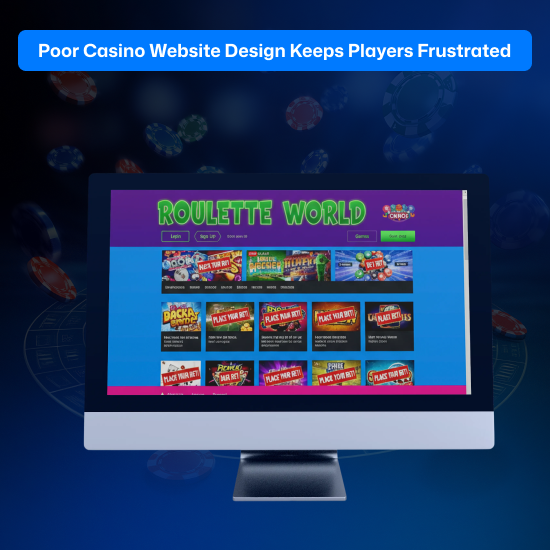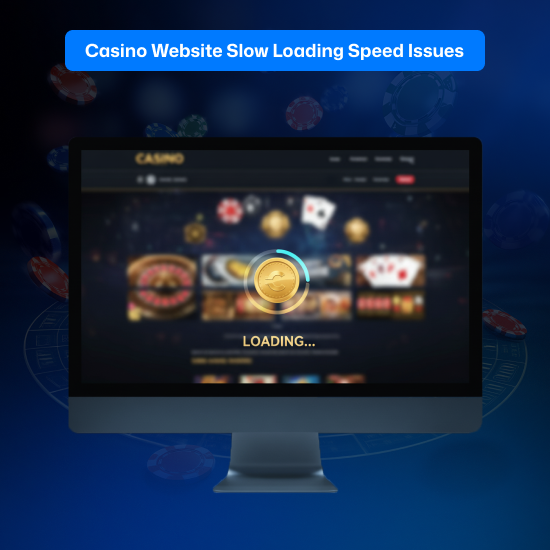Black Friday Special! Buy any 1 product and get 1 absolutely free — this offer applies to all Website Templates, UI Kits, and Complete Scripts.
Buy Now!
Players rarely leave a casino site without a reason. Most departures happen quietly. No complaints, no messages, no second chances.
One day, a user logs in, doesn’t find what they need, and never returns. Understanding why this happens is the difference between building a successful platform and slowly losing the audience you worked so hard to earn.
Below is a deep dive into the most common reasons players abandon casino websites and exactly what you can do to fix them.
Design is usually the first signal a player receives about whether your platform is safe, enjoyable, and worth their time. When the design feels outdated, inconsistent, or overwhelming, players sense frustration before they even start exploring.
They may not complain about it, but they feel it.

A layout that feels visually heavy or disorganized. The home page has only three sections where a single video appears, and the other sections are floating.
Clashing colors or graphics make the site look unprofessional. The light red color appears on the landing page, while the footer color is sky blue.
Navigation that forces players to guess where to click next. The cluttered flow frustrates them what to do now.
Pages that don’t align with modern standards. The UI elements are wrongly used on the platform, and the resolution is poorly maintained.
Confusing menus or hidden features. Even a pro casino player can’t find the relevant games easily from the homepage.
These subtle design problems don’t just annoy players; they create doubt. Doubt about professionalism. Doubt about safety. Doubt about the platform as a whole.
It can’t be acceptable while getting a legal license for a casino website with long procedures.
Clean, structured layouts that guide the eye naturally. Prioritize the elements in design and map the user flow accordingly.
Consistent branding that communicates reliability. Use UI components like visuals, icons, and images on the web pages that convey professionalism.
Clear navigation paths that reduce decision fatigue. Implement a breadcrumb bar to help players know when they’re.
Minimal clutter, maximum clarity. This fundamental UI/UX design principle every digital product has to follow, including a casino website design.
Routine design audits for usability. Check if the 2-year-old developed site is still easy to use or needs improvement.
A well-designed casino site isn’t just pretty. It’s calming, reassuring, and respectful of the player’s time and energy.
When a player opens a casino platform, whether on a desktop or a smartphone, they want an immediate experience. Not a waiting game. Not a spinning loader. Not a half-broken mobile version that forces them to squint or refresh.
Impatience isn’t the issue. The expectation is.
Players are used to speed, and anything less feels like a burden.

Games that take too long to load, at least 15-40 seconds just for presenting the welcoming screen.
Slow or unstable mobile pages that look different in the desktop version.
Buttons that lag or freeze mid-action. This is the most annoying thing players have ever experienced.
Heavy assets that slow down gameplay. The animation or video keeps the navigation stuck, and it is not acceptable.
Device compatibility issues. The game works better on Windows devices, but when it comes to Android and iOS, the site lags and shuts down automatically.
Players are usually multitasking or on the move. If they can’t trust the site to perform smoothly on their phone, they simply stop trying.
Compress and optimize all graphics. Whether it’s a JPG image or an embedded video, make sure it loads quickly and doesn't slow down the site.
Strengthen servers and load balancing. It’s good to have a CDN for your server that helps website content load easily worldwide.
Prioritize a mobile-first approach. In a website development, a mobile-friendly design and coding practices keep the platform ready to get more players who love to play casino games on smartphones.
Remove unnecessary scripts. Whether it’s a CSS, JS, or React code that increases the cognitive load of the overall site, then delete it.
Regularly test with real devices, not just emulators. Use different Android devices or desktop screens to check the functionality as it works correctly or not.
A fast, responsive experience shows players that the platform respects their time and that matters more than most operators realize. This can improve casino website traffic.
UX is the invisible element of a casino site. When it’s strong, everything feels natural. When it’s weak, every action becomes a headache.
Players don’t always complain about poor UX. They just quietly stop engaging.

Searching for basic features that should be obvious. For example, a sign-up button is not available on the landing page’s header but is present on the mid-section banner.
Not knowing where to find recent games. The nav bar does not have a game section; usually, a professional casino website does.
Confusing wallet or account settings. The built-in wallet shows multiple currencies with different rates. While the profile setup and modification are not as easy as possible.
Overcrowded dashboards. Not displaying the current playing games, balance, withdrawal balance, etc, makes players feel doubtful.
Inconsistent interfaces from one page to the next do not sound professional.
Every extra click takes mental effort. And mental effort increases friction. The more friction, the faster the exit.
Create predictable, intuitive flows for key actions from landing on the home page to entering the game in 2 steps.
Reduce unnecessary complexity. Avoid too many technical terms or pages that confuse the players.
Highlight important features with clear visual cues. Use the animations or icons wisely. Check if they increase the site load.
Use familiar UX patterns players recognize. For example, Home Page → Game (Demo) → Sign Up → Deposit → Wager/Win.
Continuously collect real user feedback. Listen to what they’re saying and improve the website performance.
Great UX makes players feel in control. Poor UX makes them feel lost. The choice between the two determines their loyalty.
The best solution is to go with the premium website Figma UI design kits. With a user-centric approach and optimization, it makes the task easier for the development team to focus on important things, not repetitive tasks.
Presenting the Casino website UI design kit.

Trust isn’t something players consciously look for, but the absence of it is immediately felt.
In online gaming, players want reassurance that their money, data, and experience are protected. When that reassurance is missing or unclear, even the most tempting bonuses can’t overcome the discomfort.

Missing or hidden licensing information. It’s very obvious without the prior license how the casino activities can happen. These questions are about the reputation.
Design elements that look unprofessional. The checkmarks and the trusted authority logo are not present on the footer also creates doubt.
Bonus terms that feel unclear or misleading. For example, deposit $5 and get $500 bonus into your wallet. This is unrealistic to trust.
Lack of transparent payout or RTP information. Not displaying the withdrawal balance and real-time play transactions feels suspiciously fraudulent.
No visible security measures. When a player visits the casino website, there are no safety signs or animations that indicate they are in a trap.
Players need to feel safe before they feel excited. If you can’t convince them, they surely won't prioritize the platform.
Display all licensing details clearly and proudly. Don’t hide anything related to saying your casino business is legally approved, not a scam.
Use strong encryption and recognizable security symbols. To protect website visitors’ data and fund management in the game, it’s required.
Publish transparent terms in plain language. Wages, winning rewards exchange, etc, have to be defined with a clear understanding.
Add clear RTP and fairness information. Simply explain what kind of risks are involved while playing casino on a website.
Highlight third-party audits or certifications. Displaying the trusted organization's accreditation makes players feel safe to play.
Transparency builds emotional comfort, and emotional comfort leads directly to player retention.
A great game can lose its appeal if it’s presented poorly. Players should feel engaged the moment they see a game tile, not confused or underwhelmed.

Blurry or outdated thumbnails. The images are not clear to see, especially on mobile phones. So, users want to sign up for the contest, even though it’s rewarding.
No explanation about what makes a game interesting. Simply listing the game in an HTML layout and not using the dynamic visuals could evaporate the trust.
Missing RTP or volatility details. A casino game depends on how much a player will earn after putting money into playing. Not mentioning the potential risks also creates doubt.
Uninspiring categories like “All Games” with no curation. Having 50+ casino games available on the platform but not categorized by preferences still loses the business.
No visual cues for trending or new games. To create excitement in the community, it’s important to highlight what fresh games are introduced.
Players want guidance, inspiration, and clarity. They don't like a wall of generic game icons.
Use high-quality graphics for all game tiles. Avoid stock images and invest in professional graphics, preferably made by experts.
Add short, easy-to-read descriptions. Write the content as players want to read and start playing.
Highlight important gameplay details such as minimum deposit, maximum return, or wager limits.
Introduce intelligent, engaging categories (Trending, 10K+ Users, etc). Don’t be generic, but make them feel innovative to stand out.
Refresh visuals regularly to maintain excitement. Static appearance for months delays the trust, but a dynamic presentation will maintain the credibility.
This process works as follows: Strong visuals spark curiosity. Curiosity leads to clicks. Clicks lead to gameplay and retention.
Players stay where they feel valued, not to be treated as a casual person.
When the experience feels generic or disconnected from their behavior, it creates emotional distance. That distance grows until they leave.
Personalization isn’t about overwhelming players with offers. It’s about connecting with them in a way that feels human and thoughtful.

Bonuses that match their preferences. For example, if they win $100 in a slot game, then a 5-free spin will be credited to their account.
Recommendations based on their favorite games. Exploring the previous game categories to take an interest in new launches will help them start playing immediately.
Loyalty tiers that genuinely reward long-term play. If the player completes daily 15-day or 3-month play, they’re entitled to a return gift as a loyal player.
Recognition for milestones. When a player completes 50 levels of a slot game or wins a poker table consecutively 10 times, they want to feel a pro playing experience.
Progress they can see and feel. Achieving a top rank on the leaderboard gives them an outstanding feeling.
When players feel invisible among thousands of other players, they drift away.
Tailor rewards based on real behavior, not guesswork. If a player usually plays the casino game twice a week, they’ll get 1 free spin, while a daily player gets 10 more credits.
Use segmentation to deliver relevant offers. This will make a more personalized appeal to players without feeling them just a lead for business.
Build a loyalty system with real progression. For retaining players in the casino business, it’s important to have.
Make bonuses easy to understand and redeem. If partnering with other third-party businesses for a bonus promotion, check that it’s easy to redeem.
Show players their journey and celebrate achievements. Gamified UI elements are key to driving success on your casino websites.
Keep note that when players feel understood, they stay. When they feel valued, they return.
A player’s journey doesn’t end after their first visit. In many cases, that’s where the real relationship begins. But when follow-up feels generic, inconsistent, or overwhelming, they disconnect emotionally.

Emails that feel robotic or irrelevant. Sending emails every week twice without adding any value, like free spin activation or an exclusive bonus.
Too many promotions with no personalization. Just sharing a new game launch, but not the strategies to make a strong chance of winning sounds generic.
No check-in after long periods of inactivity. If players don’t get a hear back message from the game again to re-engage them, they feel left out.
Poorly timed messages. Sending the emails at 10.00 PM or the SMS promo code at 11.00 AM is just as neglectful, as it can’t get the attention of players.
Absence of storytelling or emotional connection. Without triggering the player’s preferences and what they are interested in makes them just a simple player. This increases the churn rate.
Understand that players want to feel remembered, not targeted.
Segment communication based on real behaviors. If player A is usually open to the game three times a month, then send offers accordingly. While player B is more active in the casino, they provide more promotions to feel valued.
Send messages that speak to their interests. Poker gamers get only the relevant game tips, while slot and roulette players get more tips to increase their chances of a big win.
Create onboarding flows that guide and support. Simply embed the short video on the game landing page, helping new players to register and start playing.
Offer thoughtful incentives at the right time. For example, if a player won the poker table, then immediately the pop-up has to show “Congratulations! You won $50 value bonus.”
Check in when players drift away, not just when you want deposits. If you notice users not taking an interest in the games, implement the plan to get them back. Only welcoming when they make a deposit feels like your business loves only earning, not offering.
Retention in casino games is successful in relationships. Relationships become thoughtful communication.
When players can’t access their money easily, they lose trust immediately. Payment experiences weigh heavily on emotional comfort, and even one bad withdrawal can end a long-term relationship with a site.

Delayed withdrawals with vague timelines. Not showcasing the expected date and time for processing the withdrawals will be looked at as suspicious monetary cheating.
Limited deposit options. Just allowing selected FIAT currencies (US$, Euro, or GBP) restricts your website's reach to only those countries’ players. Allowing digital payments like crypto also attracts other players to join.
Unexpected fees. Charging withdrawal fees without any clarification also questions players why they have to pay for cashing in the winning amount.
Confusing verification steps. Mentioning 3-step payment verification on the screen, and it actually takes 5 steps, will be doubtful.
A lack of real-time updates during processing is not acceptable. Players feel their money is at risk.
These aren’t just inconveniences. They reduce the core of player trust.
Offer a wide range of reliable payment methods. From digital wallets to crypto payments will amaze users to prefer their own choices to deposit the amount.
Communicate withdrawal times clearly and accurately. Display at what time the funds will be released and how much in fees have to be paid.
Simplify verification without sacrificing security. Whether it’s a bank account verification or other wallets, make sure it’s easy and not confusing.
Provide live status updates for every transaction. From a successful deposit to a withdrawal request, everything should be on point.
Use trusted payment partners to ensure consistency. Integrating a payment gateway into the website that is widely recognized in the world re-establishes trust.
When a platform handles money smoothly, players immediately feel safer and more willing to return.
Online casino players don’t leave because of one big reason. They leave because of dozens of small ones. A slow page here. A confusing menu there. A bonus that doesn’t feel personal. A withdrawal that takes longer than expected.
Each moment adds weight until the player decides it’s easier to leave than stay.
But the good news is clear: Every issue in this article we discussed can be fixed as mentioned.
Only on Google, every second approximately 99K searches are conducted. Daily this number reaches...
Software with a well-designed user interface (UI) can significantly enhance user experience, increas...
Everyone has seen the online casino industry grow. It is popular because it offers the convenience o...
Growing traffic to a casino game website isn’t about luck or simply spending more on marketing...
Now, e-commerce is not just a game of “uploading the products and praying for conversions.&rdq...
CSS has come a long way. Gone are the days when designers and developers depend on floats, clearfix...

Not sure which template or UI kit fits your project? Reach out for expert advice.